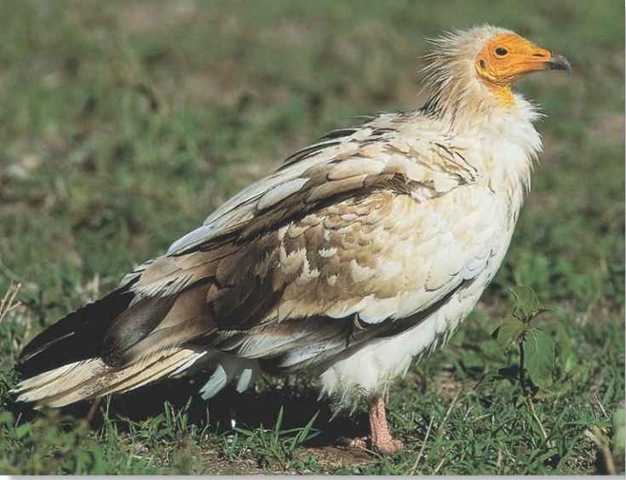ORDER
Falconiform.es
FAMILY
Accipitridae
GENUS & SPECIES
KEY FEATURES
Uses a stone as a tool to crack open ostrich eggs, which are a favorite food item
Scavenges at garbage dumps and town markets, where it thrives on a diet of rotting rubbish
Performs a spectacular sky-dance as part of its courtship display, and nests in caves on cliff faces
WHERE IN THE WORLD!
Found in much of Africa, southern Europe, Arabia and India; birds in the north-of the range spend the-winter farther south
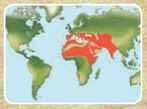
Lifecycle
More aggressive scavengers deprive it of meat at carcasses, but the Egyptian vulture is the only bird species native to Africa that can crack the world’s largest egg.
HABITAT
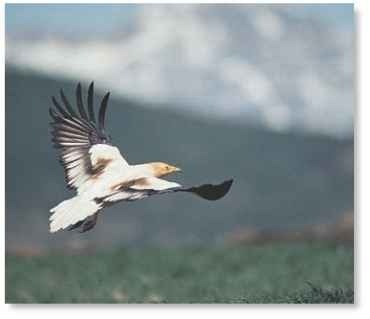
Dry, open country is the A High rise
Egyptian vulture’s traditional Warm updrafts enable the
habitat, but it is also found in vulture to soar effortlessly.
urban areas. Although modern
cities are too clean, it does visit garbage dumps within its range.
Outside urban areas, the Egyptian vulture lives in deserts, semi-arid scrub country and short-grass plains, especially where rocky outcrops or hills provide nest sites. The bird visits pasture and newly ploughed fields on farmland. It also forages along the shore and within marshes.
The Egyptian vulture has been recorded above 13,000′ in mountain ranges, but is more often seen at lower altitudes.
# Egyptian vultures lift stones as heavy as 2 lbs. and crack eggs with them.
# Usually silent, the vulture grunts, hisses and mews if angry or excited.
FOOD & FEEDING
A scavenger, the vulture eats anything it can digest. Most of its diet is carrion, but it eats all kinds of rubbish. It takes decaying fish from docks, rotting fruit from markets and waste from slaughterhouses. MThe vulture spots most of its carrion food while soaring up high above the ground. When it arrives at a carcass, the Egyptian vulture must wait until larger vultures have had their fill. Eventually its turn comes to feed, and it uses its slender, hooked bill to pick scraps of meat from the bones of the carcass.
The Egyptian vulture eats ostrich eggs as well as those of flamingos and pelicans. After it breaks open the egg, other vultures often swoop in to steal the eggs’ contents.
The vulture kills small animals, such as rabbits and fledgling birds, especially when it finds them weak or wounded. It-also eats insects.
CRACKING THE PROBLEM
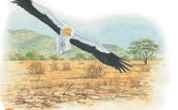
1 Search flight
Always on the lookout for feeding opportunities, an Egyptian vulture scans-the terrain as it flies over the-tops of scattered acacia trees.
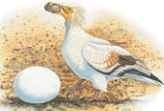
2 Stone’s throw…
Selecting a large stone, the vulture picks it up and hurls it onto one of the eggs. It usually takes several attempts to break the shell.
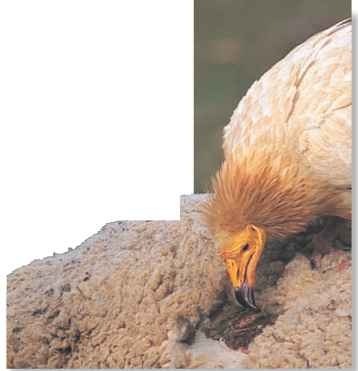
Flesh feast Vultures feed on the carcasses of small mammals and livestock.
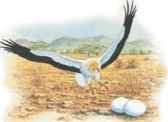
3 Eyes on the prize…
The vulture spots an unguarded ostrich nest. It lands alongside two enormous eggs, each of which may weigh 4.5 lbs.
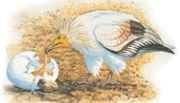
4 Runny reward
Eventually, the bird’s work pays off, and the thick shell cracks. The vulture inserts its long bill and eats the nutritious yolk.
BEHAVIOR
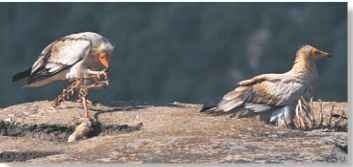
A Look-alike
The male and female are identical in appearance.
The Egyptian vulture usually lives alone or with its mate in wild areas, but often flocks near villages. Up to 100 may gather at
feeding sites and roosts. The species also forms flocks, usually of no more than 30 birds, on migration. It is does not migrate within most of its range, but leaves southern Europe for winters in Africa.
Its relatively small size enables the Egyptian vulture to take flight earlier in the morning than larger vulture species, which must wait for the sun to create rising warm air currents before they can soar
CONSERVATION
Although not seriously threatened, the Egyptian vulture has declined in , much of its range. One reason is the recent modernization of formerly primitive cultures; the result is a reduction in the availability of foodstuffs such as offal and rubbish. The largest Egyptian vulture populations are found in poverty-stricken parts of Ethiopia and India. In Europe, Spain is the Egyptian vulture’s chief stronghold.
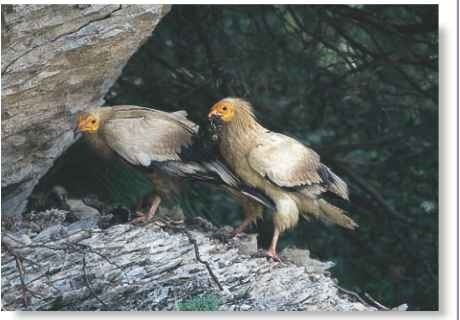
A Place in the shade
Choosing a nest site under an overhanging rock, the vulture ensures that its chicks are sheltered from direct sunlight.
BREEDING
Dramatic aerial dives and upward swoops mark the beginning of the Egyptian vulture’s spring breeding season. Pairs often roll over; touching talons in midair.
Both sexes build the nest on a ledge, in a cave or on a building. Ideally, the nest site provides a wide view of the surrounding area. The birds pile up sticks to form a platform, which is often more than 3′ wide, and line it with rubbish such as rags, paper, skin and fur. A single breeding site, such as a cliff face, may contain several nests, which are repaired and reused year after year. Unlike many other vultures, the Egyptian vulture does not form breeding colonies.
The female lays two chalky-white eggs several days apart. Both adults incubate them and rear the hatchlings. The young are fledged within three months but may stay around for another month.
Profile
Egyptian Vulture
Agile and supremely efficient in flight, the Egyptian vulture is no beauty on the ground, where it walks with a typically hunched profile.
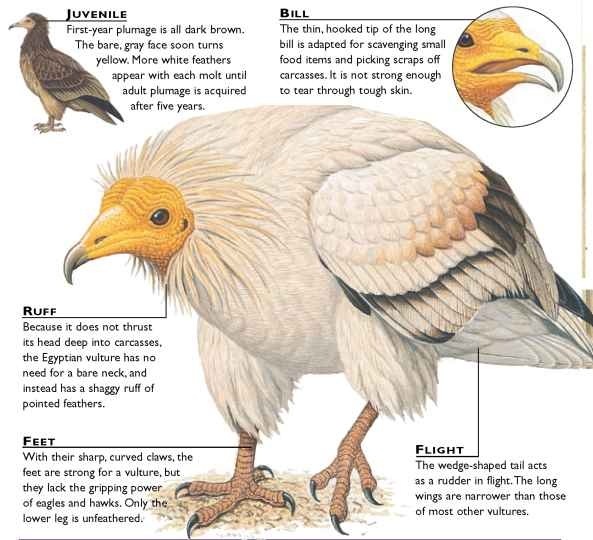
CREATURE COMPARISONS
ilack-breasted buzzard (Hamirostra melanosternon) is slightly smaller than its relative the Egyptian vulture, with a stockier build and a stouter bill. Found in Australia, the buzzard, like the vulture, prefers open, dry habitats and avoids forests. Its method of feeding is similar to that of the vulture: searches for carrion and small mammals while soaring on high, sweeping low over the ground or walking along. The black-breasted buzzard also eats large eggs, which are usually those of the emu. It breaks the eggs with its bill or hurls large stones them from a standing position.

Black-breasted buzzard
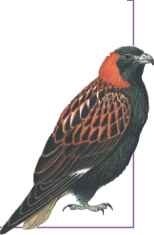
| VITAL | |
| STATISTICS | |
| Weight | 3.5-4.8 lbs. |
| Length | 23-28″ |
| Wingspan | 5-5.6′ |
| Sexual Maturity | 4-5 years |
| Breeding Season |
Mainly March-May |
| Number of Eggs | Usually 2 . |
| Incubation Period | 42 days |
| Fledging Period | 70-85 days |
| Breeding Interval | ’1 year |
| Typical Diet | Carrion, organic waste, eggs, mammals and insects |
| Lifespan | 20 years in the wild |
RELATED SPECIES
• The Egyptian vulture is among the smallest of the 15 species of Old World vulture, which are unrelated to their New World counterparts. Its closest relations are the slightly larger hooded vulture, Necrosyrtes monachus, found in Africa, and the huge lammergeier, Gypaetus barbatus, which has a wingspan of almost 10′ — double that of the Egyptian vulture — but otherwise resembles it in shape.
